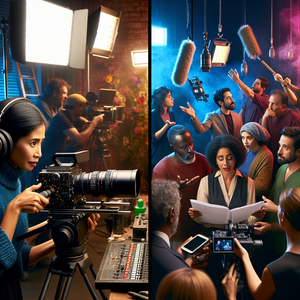
Cinematographers vs. Directors: Understanding Their Unique Roles and Career Paths in Film
The dynamic world of filmmaking thrives on a multitude of specialized roles, with cinematographers and directors at the forefront of the creative endeavor. While both positions are crucial in bringing a film to fruition, they each fulfill unique functions that shape the final product.
Job Summaries:
Cinematographer (Director of Photography):
- Cinematographers craft the visual language of a film.
- They work closely with directors to realize their creative vision.
- The role involves crucial decisions regarding lighting, camera angles, and shot composition.
- A solid understanding of camera technology, lighting techniques, and artistic vision is essential.
- Typically supported by a degree in film or cinematography and a strong portfolio of prior work.
Film Director:
- The film director is the creative leader responsible for interpreting scripts.
- Casting actors is a key responsibility of the film director.
- Directors coordinate with various department heads.
- They ensure the film conveys its intended message.
- Strong leadership skills are vital for a film director.
- Communication skills are essential for guiding the actors and crew.
- Directors guide the actors and crew throughout the filmmaking journey.
Camera Operator:
- Camera operators work under the guidance of cinematographers to capture footage that aligns with the visual plan.
- Their responsibilities include operating cameras and adjusting settings to frame shots effectively.
- Technical skills and the ability to work well in a team are essential.
Gaffer:
- The gaffer is the head electrician on set.
- Implements the lighting plan established by the cinematographer.
- Manages lighting rigging.
- Supervises the electrical crew.
- Ensures that each scene is lit safely and effectively.
Production Designer:
- Production designers are responsible for creating the film's visual concept.
- They oversee set design, location selections, and color palettes.
- They collaborate with the director and cinematographer.
- They devise immersive environments that enhance the narrative.
Script Supervisor:
- Tasked with ensuring continuity throughout production, the script supervisor maintains strict adherence to the script.
- They meticulously track dialogue, actions, and props to ensure consistency from shot to shot.
Editor:
- Film editors are responsible for assembling the footage shot during production into a cohesive final product.
- They work closely with directors to understand the film's vision, making creative decisions regarding pacing and transitions.
Sound Designer:
- Sound designers shape the auditory experience of a film.
- They integrate sound effects, dialogue, and music.
- They collaborate with directors and editors.
- They ensure the audio complements the visual elements seamlessly.
Lighting Technician:
- Lighting technicians assist the gaffer by setting up and operating lighting equipment on set.
- Their responsibilities include rigging lights and ensuring effective lighting for each scene.
Casting Director:
- Casting directors are responsible for selecting actors for a film.
- They collaborate closely with the director to understand character requirements.
- They conduct auditions.
- They review submissions.
- They negotiate contracts with talent.
Each of these positions contributes uniquely to the filmmaking process, providing numerous avenues for aspiring professionals to explore. With the industry's ever-changing landscape, job growth projections for cinematographers and directors remain encouraging, driven by technological advancements and a growing appetite for diverse content.
Explore More Jobs

